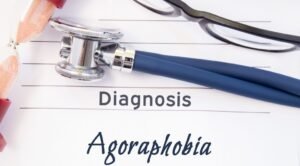Panic Disorder Overview:
Panic disorders are usually identified by extreme feelings of apprehension or intense fear that may appear suddenly or “out of the blue”. They may or may not have an apparent cause. In most cases, intense panic usually lasts no more than a few minutes but in rarer circumstances it can continue for up to about two hours. If you’re having a panic attack and ultimately have developed a panic disorder you should notice some of the following symptoms:
A fear of dying
Fears of going crazy or losing control
Shortness of breath or a feeling of being smothered
Heart palpitations, pounding heart or accelerated heart rate
Chest discomfort or pain
Dizziness, faintness or unsteadiness
Hot and cold flashes
Shaking and trembling
Numbness or tingling in feet and/or hands
Sweating
Feeling of choking
Abdominal distress or nausea
Feeling of unreality is if you’re not all there
In a full-blown panic attack, at least four of the symptoms will be present. In a limited-symptom attack you may experience possibly two or three of the symptoms.
Panic Attack or Panic Disorder:
If you experience (1) two or more panic attacks and had of at least (2) one of these attacks followed by a month of concern about continuing panic attacks or their consequences, you may be experiencing a panic disorder. In most cases, panic disorder by itself does not usually involve the development of a phobia. The panic itself is usually spontaneous rather than when you’re approaching, thinking about or entering a phobic situation. In many cases, its spontaneity and unexpected nature makes it difficult to recognize any apparent cause. Also, panic attacks are not the result of physiological precipitating factors such as a drug use or withdrawal or a medical condition.
You can possibly have several panic attacks within a month or two and never have another one for years, or may never have a recurrent attack. Or you could have several attacks, followed by a period of time with no attacks, only to have the panic return several months later. Panic attacks can have many different symptom patterns. You could have several within a week or many within the same month. In all of these cases, there is a tendency to develop anticipatory anxiety which is a deep feeling of apprehension and fear about having further attacks. It is usually after several attacks that individuals seek treatment.
Diagnosing Panic Disorder:
People having panic attacks frequently go to the emergency room or otherwise seek a medical or physiological answer to why they are feeling heart palpitations and excessive anxiety. They are often very frightened by the symptoms which often lead to an EKG or other cardiac tests which in most cases turn out to be normal. Occasionally, they may find a mitral valve prolapse (a benign arrhythmia of the heart) which may coexist with the panic attack. However, doctors have become much better at distinguishing between purely physical complaints, anxiety attacks and panic disorders.
A diagnosis of a panic disorder is only made after ruling out all possible medical considerations including hyperthyroidism, reactions to excess caffeine, hypoglycemia or withdrawal from alcohol, tranquilizers or sedatives. The root cause of panic disorder is most often some combination of heredity, personal stress and chemical changes within the body and brain.
The specific criteria for panic disorder can be found on another page of this website but in summary it requires recurrent and unexpected panic attacks of the previously mentioned symptoms. At least one of the attacks must be followed by a month or more of persistent concern, maladaptive change in behavior, and the disturbance cannot be attributable to the physiological effects of a substance or any other medical condition. Also, the disturbance cannot be better explained by any other mental disorder.
Development of panic disorder:
People most often first develop panic disorder in their late teens and early twenties. In some cases, the panic disorder can become complicated by developing into agoraphobia. It is estimated that between 1% and 2% of the population have a pure form of panic disorder while approximately 5% experience panic disorder with agoraphobia.
Panic Disorder Treatment:
Effective treatment for panic disorder usually requires both physiological and/or psychological intervention. Physiological treatments usually involve medications specifically for anxiety referred to as anxiolytics or anti-anxiety drugs, and/or antidepressants to reduce the symptoms of panic attacks. Psychological interventions frequently include lifestyle and personality changes, psychotherapy, and relaxation training.
Some of medications used to treat panic disorder include the benzodiazepine medication such as Xanax, Ativan, Valium or Klonopin. Also, antidepressants may be used such as Paxil, Serzone, Zoloft, or Celexa. These medications are most effectively used in conjunction with psychological interventions however.
A common sense understanding of the psychological dynamics associated with an individual’s experience of anxiety and panic disorders is imperative. Frequently, there are precipitating events or experiences that seem to maintain or exacerbate underlying symptoms of anxiety. Only by recognizing, problem solving and focusing on these precipitating and exacerbating experiences, may you truly have a reduction in your anxiety symptoms. There are various lifestyle and personality changes that can be used to focus on and reduce the symptoms of panic disorder including stress management, eliminating stimulants and sugar from your diet, regular exercise, slowing down your life and creating some “downtime” and even focusing on personality characteristics such as expecting too much of yourself, having excessive need to please others or even an excessive need for control of your life or others.
Relaxation training can be helpful also. Practicing breathing from your abdomen and some type of progressive muscle relaxation on a daily basis has been found to be helpful by many people. This may be helpful in reducing the physical symptoms of panic as well as helping to bring an element of control into your life, and possibly reducing the feeling of anticipatory anxiety that you may have before having a panic attack. Physical exercise is also recommended to assist in reducing underlying symptoms of anxiety.
Psychological interventions also include a form of panic control therapy which focuses on eliminating catastrophic thoughts such as “I’m going to have a heart attack”. Cognitive behavioral therapy is frequently used effectively in assisting people to understand the connections between their thinking and moods as well as physiological reactions. Many times, these catastrophic thoughts are believed to trigger panic attacks.
Another psychological intervention is referred to as interoceptive desensitization. This type of desensitization involves voluntarily habituating to the bodily symptoms of panic such as sweaty hands, shortness of breath, dizziness and rapid heartbeat. Often the symptoms are created deliberately in a therapist’s office through such activities as spinning in a chair to create dizziness, or rapid heartbeat by running up and down stairs. Repeatedly being exposed to unpleasant bodily symptoms promotes desensitization which means adjusting to and learning to cope better with the actual symptoms associated with panic attacks and panic disorder.
Summary of Panic Disorder:
Panic attacks and panic disorder can become very uncomfortable and even disabling. If not treated they can become even worse resulting in such comorbid conditions as panic disorder with agoraphobia. Thankfully, psychological and physiological treatments are available to effectively assist with panic disorder.
Some information adapted by Paul Susic Ph.D. Licensed Psychologist from The Anxiety and Phobia Workbook Third Edition by Edmund J. Bourne Ph.D.




